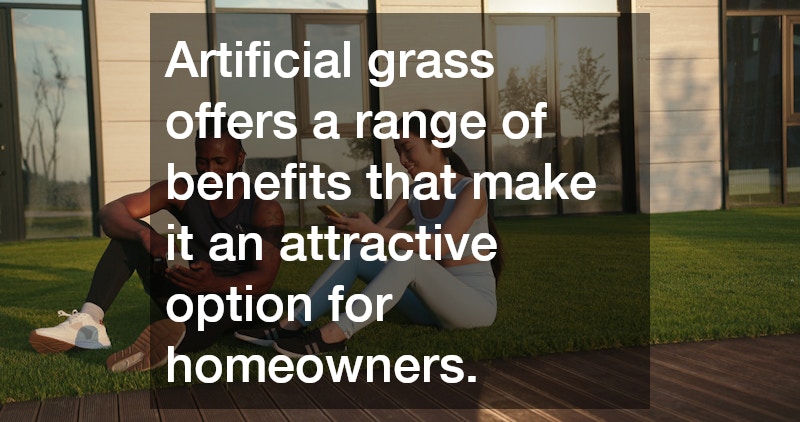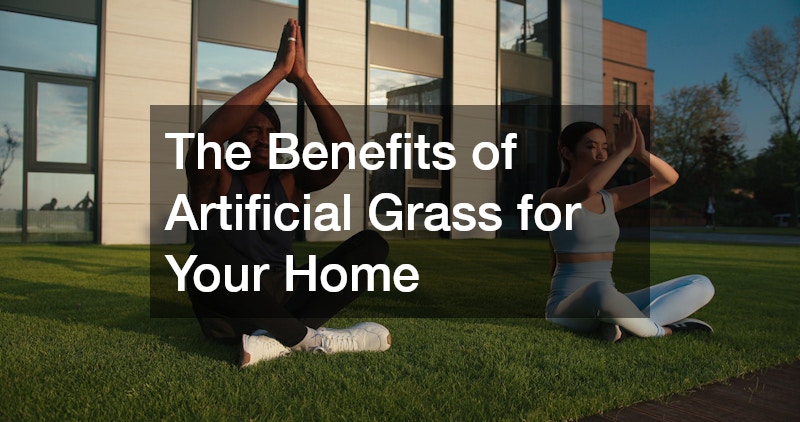In recent years, there has been a growing trend of artificial grass in residential areas. As more homeowners seek low-maintenance and aesthetically pleasing options for their lawns, synthetic turf is becoming an increasingly popular choice. This shift is driven by a variety of factors, including convenience, durability, and environmental considerations, making it a viable alternative to natural grass.
Why Choose Artificial Grass Over Natural Grass?
Low Maintenance Requirements
One of the most appealing aspects of artificial grass is its low maintenance requirements. Unlike natural grass, which demands regular mowing, watering, and fertilizing, synthetic turf allows homeowners to maintain a neat lawn with minimal effort. This reduced upkeep is particularly beneficial for busy individuals who want a beautiful yard without the time-consuming chores.
In addition to saving time, artificial grass can also save money on lawn maintenance. The cost of purchasing fertilizers, lawn mowers, and other maintenance equipment adds up over time, making artificial turf a cost-effective solution. By eliminating these routine tasks, homeowners can enjoy a pristine lawn year-round without the hassle.
Furthermore, reduced maintenance means less stress on the environment. Without the need for gas-powered mowers and other lawn care equipment, artificial grass minimizes noise pollution and energy use. This not only benefits the homeowner but also contributes to community well-being and environmental conservation.
Water Conservation
Water conservation is another key benefit of choosing artificial turf over natural grass. In regions prone to drought, maintaining a green lawn can be challenging and wasteful. Synthetic turf provides a reliable solution, as it requires no watering to remain lush and vibrant.
The American Water Works Association estimates that the average family uses 320 gallons of water per day, with about 30% dedicated to outdoor uses. Switching to artificial grass can drastically reduce water consumption, helping both individual households and communities conserve this precious resource. This is especially important in areas where droughts are common and water restrictions are in effect.
Long-Term Cost Savings
While the initial investment in artificial grass may be higher than that of natural sod, the long-term cost savings are significant. Over time, reduced maintenance and zero water expenses make synthetic turf a financially sound choice. Many homeowners find that these savings offset the upfront cost within a few years, offering both short-term and long-term value.
Additionally, artificial grass eliminates many of the costs associated with traditional lawn care. There’s no need to purchase lawn mowers, trimmers, fertilizers, or pesticides, which can quickly add up over time. Homeowners can instead allocate these funds to other home improvement projects or personal interests, adding value in different areas of their lives.
How Does Artificial Grass Impact Environmental Sustainability?
Reduction of Chemical Use
One of the major environmental benefits of artificial grass is the reduction of chemical use. Natural grass often requires treatments such as pesticides and herbicides to remain healthy and vibrant. In contrast, artificial turf does not support weed growth or pest infestations, eliminating the need for these potentially harmful chemicals.
This reduction in chemical use contributes to a healthier environment and reduces the chemical runoff into local waterways. Contaminants from fertilizers and pesticides can have deleterious effects on aquatic ecosystems, affecting both plant and animal life. By not needing these chemicals, artificial grass helps protect local ecology and promote biodiversity.
Recyclable Materials
Artificial grass is often made from materials that can eventually be recycled, adding to its sustainability. Many manufacturers now offer products made from recycled plastics or other eco-friendly materials, contributing to less waste and a lower carbon footprint. This consideration is an important factor for environmentally conscious homeowners looking to make sustainable choices.
At the end of its lifespan, artificial turf can be recycled and repurposed rather than ending up in a landfill. This helps close the lifecycle loop, allowing materials to be reused and reducing the burden on waste management systems. This recycling capability showcases a commitment to sustainability, emphasizing the circular nature of contemporary product design.
Carbon Footprint Considerations
The carbon footprint of artificial grass is another important consideration when comparing it to natural grass. The production and transport of synthetic turf do result in carbon emissions, but these are often offset by the eliminated need for lawn care equipment, fertilizers, and watering over the product’s lifetime. This potential for reduced long-term emissions makes artificial grass an attractive option for eco-conscious individuals.
Moreover, synthetic turf reduces the demand for gasoline-powered lawn mowers and trimmers. This reduction in fossil fuel use can have a positive environmental impact, decreasing household emissions significantly. In addition, by lowering water usage, artificial grass helps reduce the energy required for water treatment and distribution, further contributing to a decreased carbon footprint.
What Are the Aesthetic and Practical Benefits?
Year-Round Green Appearance
Artificial grass offers homeowners the benefit of lush, green lawns year-round, irrespective of weather conditions. Unlike natural grass, which can brown or die during droughts or cold seasons, synthetic turf remains consistently vibrant. This consistent visual appeal is a major draw for those prioritizing aesthetics in their landscaping.
The year-round green appearance of artificial grass not only enhances curb appeal but also boosts property value. A well-maintained lawn is a critical component of first impressions, contributing to an overall perception of care and precision. This visual continuity can appeal to prospective buyers if homeowners ever decide to sell.
In addition to its visual benefits, the consistent look of artificial grass complements a wide range of landscaping designs. Whether aiming for a modern, minimalist layout or a lush, traditional garden, synthetic turf provides a versatile base that adapts to different styles and preferences. This flexibility allows homeowners to express their creativity without being bound by seasonal changes.
Artificial grass offers a range of benefits that make it an attractive option for homeowners. Its low maintenance requirements, water conservation potential, and long-term cost savings demonstrate its practicality. Furthermore, the environmental impact of reduced chemical use, recyclable materials, and decreased carbon footprint supports sustainable living, while year-round beauty, durability, and design versatility offer aesthetic and functional advantages.



